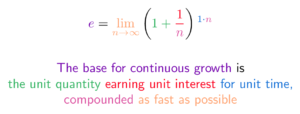E (Compound Interest Definition)
Colorized Definition
.png)
Plain English
What is e? A constant (2.718...) representing continuous unit growth: the unit quantity (1.0), continuously growing the unit rate (100%), for unit time (1 period).
Why's e special? All circles are the unit circle, scaled up. All continuously growing systems are e^{rt}, scaled to some rate and time.
When should I use e? Use e^{rt} for things that change constantly (radioactive decay, populations). For growth based on discrete intervals (interest payments, combinatorics), (1 + rate)^{time} is a better model.
## Read More
- [An Intuitive Guide To Exponential Functions & e](https://betterexplained.com/articles/an-intuitive-guide-to-exponential-functions-e/)
- [Common Definitions of e (Colorized)](https://betterexplained.com/articles/definitions-of-e-colorized/)
- [Q: Why is e special? (2.718..., not 2, 3.7 or another number?)](https://betterexplained.com/articles/q-why-is-e-special-2-718-not-other-number/)

